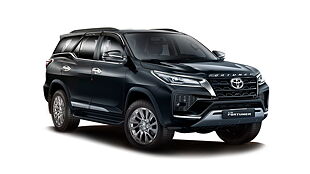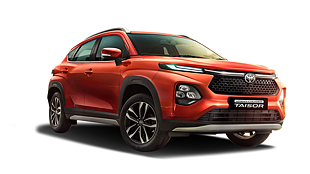Introduction

What you see here are two rather different takes on comfortable long-distance workhorses.
In the purple corner we have Toyota’s new Innova Crysta Automatic, a stonking big people carrier that leans on the legendarily reliable status of the original model. Serving a similar recipe in the white corner is the Mahindra XUV500 Automatic which is about the same size but dons the high-riding look of a typical SUV.
Why pit them against each other? Simple, both are different responses to a question often asked nowadays. That question usually goes like, “I’ve Rs 20-odd lakh to spend on a large 7-seater automatic car. What are my options?” Time to figure out the apt response…

Solid road presence

On the surface, the Innova Crysta and the XUV500 couldn’t have looked any more different (both belong to different spheres of the utility segment, after all). While the Toyota represents an aggressive yet stylish take on the full-size MPV space, the Mahindra has crossover design cues all over it. Naturally, the latter has a more impactful stance thanks to its towering height and massively beefed up wheel arches. The XUV, then, is big, brawny and everything a typical Indian looks for in a large crossover.
The Innova Crysta, on the other hand, has freshly arrived and accordingly looks new age. As far as generation changes go, the Crysta is a far cry from the old model, especially the front-end look. Gone is the old meek and boring looking fascia and in its place is a design which is a lot more expressive, thanks to a large hexagonal grille and the twin-slat chrome grille that merges neatly into the headlamps. Now although these upgrades have added fair bit of muscle to the van-like proportions, it’s no secret that it would still be difficult for the Innova to be as desirable as the XUV in the eyes of the SUV-favouring janata.

Practical insides

Inside the Innova Crysta, everything from the design, layout and the material has changed for the good, well nearly. Yes, the dashboard is more cluttered than before but there is no denying that it’s thoroughly modern and pleasing to look at. The centre console is dominated by a 7-inch display integrated nicely into the layout and sitting atop a neat series of knobs and buttons for the climate control. In terms of quality, all the buttons and dials have a tactile feel and the leather-wrapped steering wheel feels great to hold as well. What also come as a neat touch are the softly padded door armrests and the sun visors.

Next to the new Innova, the XUV’s interior is less pleasing to the eye. It looks up to date nonetheless and the blend of black and beige upholstery works well in adding to the overall sense of space. What lets the cabin down though are the low-grade plastics on contact points like the door pads and the air vents. That said, fit and finish on both these vehicles is only above average. While the Toyota’s cabin feels sturdy and rugged, it is plagued with a couple of ill-fitting bits like the dash-mounted cup holders and the flimsy glove box opening switch. Worse still, the XUV feels more utilitarian as some of the dash plastics simply do not feel apt for a vehicle costing upwards of Rs 20 lakh.
That aside, both are evenly matched when it comes to technology and connectivity. There’s touchscreen audio system with Bluetooth, electrically adjustable driver’s seat, climate control, electrically foldable mirrors and lots more as standard on both the cars. All said and listed, it’s the Innova that impresses more with extra features like 7 airbags (as opposed to 6 in the XUV), better quality leather seats, start-stop button and a neatly integrated multi information display. Toyota, however, has skimped on rear disc brakes and sunroof – features that are available on the XUV.

From the driver’s seat, both offer impressive forward and rearward visibility though again, it’s the Innova that nails the comfort brief better than the XUV. Given the automatic nature of these cars, buyers are expected to spend a fair bit of time in the front and in here, it’s the Innova that treats its occupants better with a more supportive seat and heaps of adjustment for the steering wheel and the seat. Move onto the rear and things are evenly matched as the rear seats on both the vehicles are fully supportive with adequate under thigh support and a cabin wide enough to seat three adults comfortably. That said, you cannot have three occupants in this top-spec Z variant which gets captain seats.

The second row of the Toyota offers extra versatility with the sliding function for better access to the third row. Speaking of which, the third row seating in neither of these vehicles is good enough to accommodate two adults. The combination of a high floor and low seat means you end up sitting in a cramped manner with your knees locked in. For comparison’s sake, the Innova happens to have more knee room and bigger seats in the third row but frankly things are still pretty tight for your average size occupant.
In the overall scheme of things, the Innova Crysta takes the win for interior design, versatility and quality.
Automatic equals convenience

The Innova Crysta Automatic uses an entirely new ladder-frame chassis and is powered by a 174bhp/360Nm 2.8-litre, four-cylinder diesel engine. Whereas the XUV500 is more car-like, using a monocoque construction and transverse engine layout. It’s also got a much smaller capacity engine i.e. a 140bhp/330Nm 2.2-litre unit. As for the crux of this test, both these vehicles make use of a 6-speed automatic gearbox. More on that later…
Looking at the displacement, it doesn’t take long to find out that the Innova’s powertrain is more capable and surprisingly better refined, too. That said, the latter trait has a lot to do with the fact that the Innova is very well insulated.

The engine’s extra torque low down and in the mid-range makes it more effortless to get up to speed than the XUV. Despite the XUV’s more average output, the 2.2-litre engine remains pretty strong. It has no trouble pulling this from slow to medium speeds.The Innova does 0-100kmph in 11.67 seconds while the less powerful XUV takes around 0.2 seconds more at 11.92. Our tests also reveal the Toyota to be quicker under roll-on acceleration from 40-100kmph, taking 8.56 seconds compared to 9.32 seconds taken by the XUV. This is down to the quicker-shifting 6-speed unit in the Innova. It’s fairly quick and responsive when you are in a hurry and need to reel in that gap in traffic and smooth enough to waft along and cruise at par throttle. In fact, on part throttle it upshifts fairly early and uses the substantial torque of the diesel engine to make quick progress. This gearbox really allows the Innova to stretch its legs out on the highway, thanks to the tall fifth and sixth ratios. Cruising at triple digits speeds with the engine hovering at just 1,600rpm, the Innova Crysta is quite the long-distance hauler.

The 6-speeder in the XUV500 is on the lazier side and relies more on the engine’s pulling power than responding quicker but the way it works through the gears is just as smooth as the Toyota. It works best on part throttle where it upshifts at around 2,500rpm, using the engine’s wide torque spread to its advantage. Due to the relaxed nature of the gearbox and the power deficit, the XUV needs more time to make an overtake, while the more powerful (though heavier) Innova feels more flexible and willing to keep accelerating.
The Innova may be quicker of the two; however, around town it’s quite a handful. It uses a hydraulically assisted steering rack which is heavy and can be vague at times. The XUV’s steering in comparison is fairly light and makes driving at slow speeds easy and carefree. As for the ride quality, at slow speeds the Innova feels more planted partially due to its inherent refinement – it just feels like it’s put together more tightly. By contrast the XUV feels brittle over rough roads. What adds to the impressive low speed comfort in the Toyota is the better insulation from the tyres, the suspension and engine noise. All that said, the XUV has a few neat tricks up its flared wheel arches that outshine the Innova. Being 40kilos lighter (despite the full load of its giant 70-litre fuel tank), its more agile during turn in and its steering feel is nicer as well.

The Innova’s low-speed ride may offer an extra layer of cushioning from small bumps, but up the pace over undulated roads and its reactions differ from the SUV. Whereas the latter settles quicker and remains more composed, the equally stiff Innova starts to wallow and ride a little pitchy over the same bumps.
Verdict

Mahindra XUV500 Automatic
Price- Rs 20.44 lakh (OTR, Mumbai)
Rank -2nd
Final Score – 367/600
“I’ve Rs 20-odd lakh to spend on a large automatic car. What are my options?”
That’s the question we set out to respond. And a clear answer to that would eventually come down to what’s more important to the individual buyer. The XUV500 Automatic, for instance, has got a broad-shouldered road presence, lengthy equipment list and of course, that much needed blend of a smooth shifting automatic gearbox and light steering to make life easier. At Rs 20.44 lakh, it's not exactly what you would call good value, but next to the Innova it’s safe to say it represents a really good bargain. The XUV, then, is a benchmark-setting choice in many ways although it still lags behind the Innova Crysta on key parameters like interior quality, versatility and the drivetrain.

Toyota Innova Crysta Automatic
Price- Rs 25.78 lakh (OTR, Mumbai)
Rank -1st
Final Score – 385/600
This brings us to the Innova Crysta, which claims a convincing win in this test.
While it isn’t perfect, being much more expensive to buy and insure and with a high speed ride that jiggly, the Innova Crysta is a brilliant product otherwise. It’s more refined and versatile than the XUV, well put together, packed to the brim with electronic goodies and, crucially, is in for a real shout of being endlessly reliable in the long run.
Photos by Kapil Angane
Click here to read our comprehensive road test of the Toyota Innova Crysta
Click here to read our first drive report of the Mahindra XUV500 Automatic
Specification
| CAR NAME | Toyota Innova Crysta | Mahindra XUV500 |
| Variant | ZX 2.8 AT | W10 AT |
| ENGINE | ||
| Fuel | Diesel | Diesel |
| Installation | Front, transverse | Front, transverse |
| Displacement | 4 cyls, 2795cc | 4 cyls, 2179cc |
| Power | 174bhp at 3400rpm | 138bhp at 3750rpm |
| Torque | 360nm at 1200-3400rpm | 330Nm at 1600rpm |
| Power to weight | 93.04bhp per tonne | 75.61bhp per tonne |
| Torque to weight | 192.51Nm per tonne | 180.82Nm per tonne |
| Gearbox | 6-speed automatic | 6-speed automatic |
| CHASSIS & BODY | ||
| Kerb weight | 1880kg | 1840kg |
| Tyres | 215/55 R17 | 235/65 R17 |
| Spare | Full-size | Full-size |
| STEERING | ||
| Type | Rack and pinion | Rack and pinion |
| Type of assist | Hydraulic | Hydraulic |
| Turning circle | 10.80m | 11.20m |
| BRAKES | ||
| Front | Discs | Discs |
| Rear | Drums | Discs |
| Anti-lock | Yes | Yes |
Test Data
| CAR NAME | Toyota Innova Crysta | Mahindra XUV500 |
| Variant | ZX 2.8 AT | W10 AT |
| PERFORMANCE & BRAKING | ||
| 0-20kmph | 1.01s | 1.08s |
| 0-40kmph | 2.69s | 2.93s |
| 0-60kmph | 4.81s | 5.29s |
| 0-80kmph | 7.74s | 8.08s |
| 0-100kmph | 11.67s | 11.92s |
| 0-120kmph | 16.63s | 17.03s |
| 20-80kmph in 3rd gear (kickdown) | 6.73s | 6.75s |
| 40-100kmph in 4th gear (kickdown) | 8.56s | 9.32s |
| 80-0kmph | 25.45m | 27.55m |
| FUEL ECONOMY | ||
| City | 9.80kmpl | 9.40kmpl |
| Highway | 13.90kmpl | 13.81kmpl |
| Tank size | 55 litres | 70 litres |
| Range | 556km | 690km |
| INTERIOR MEASUREMENTS | ||
| Front | ||
| Legroom(Max/min) | 820/610mm | 890/640mm |
| Headroom | 1020mm | 960mm |
| Shoulder room | 1460mm | 1470mm |
| Backrest height | 630mm | 600mm |
| Rear | ||
| Legroom(Max/min) |
1010/760mm |
900/670mm |
| Ideal legroom | 830mm | 790mm |
| Headroom | 1020mm | 960mm |
| Shoulder room | 1460mm | 1460mm |
| Seat base length | 490mm | 480mm |
| Backrest height | 630mm | 600mm |
| Boot | 983 litres | 570 litres |
| Length/width/height | 1210/1270/640mm | 850/1200/480mm |
| Loading lip height | 710mm | 750mm |
Score sheet
| Parameters | Max points |
Toyota Innova Crysta |
Mahindra XUV500 |
| DRIVING FEEL | |||
| Steering response | 20 | 8 | 9 |
| Directional stability | 25 | 13 | 13 |
| Engine characteristics | 25 | 17 | 16 |
| Gearbox | 20 | 13 | 12 |
| Visibility | 10 | 7 | 7 |
| Intermediate results | 100 | 58 | 57 |
| SPACE | |||
| Front Space | 25 | 20 | 17 |
| Rear space | 25 | 18 | 18 |
| Feeling of space | 20 | 16 | 15 |
| Boot space/flexibility | 20 | 20 | 18 |
| Payload | 10 | 7 | 9 |
| Intermediate results | 100 | 81 | 77 |
| IN THE CABIN | |||
| Comfort equipment | 25 | 16 | 15 |
| Operatibility | 15 | 11 | 10 |
| Feel of quality | 20 | 12 | 11 |
| Front seats/ingress | 20 | 16 | 15 |
| Rear seat/ingress | 20 | 15 | 13 |
| Intermediate results | 100 | 70 | 64 |
| PERFORMANCE | |||
| Acceleration | 25 | 17 | 17 |
| Top speed | 10 | 8 | 7 |
| Driveability | 30 | 24 | 23 |
| Braking | 25 | 21 | 19 |
| Environment | 10 | 5 | 4 |
| Intermediate results | 100 | 75 | 70 |
| ROAD MANNERS | |||
| Ride quality | 30 | 20 | 18 |
| Turning circle | 15 | 12 | 12 |
| Handling | 20 | 10 | 9 |
| Manoeuvrability | 15 | 8 | 9 |
| Safety | 20 | 12 | 12 |
| Intermediate results | 100 | 62 | 60 |
| PRICE | |||
| Price | 45 | 8 | 10 |
| Resale | 10 | 8 | 6 |
| Warranty | 10 | 7 | 7 |
| Fuel efficiency | 35 | 16 | 16 |
| Intermediate results | 100 | 39 | 39 |
| Total | 600 | 385 | 367 |

![टोयोटा इनोवा क्रिस्टा [2016-2020] इमेज टोयोटा इनोवा क्रिस्टा [2016-2020] इमेज](https://imgd.aeplcdn.com/272x153/n/cw/ec/20623/innova-crysta-exterior-right-front-three-quarter.jpeg?q=80)

























